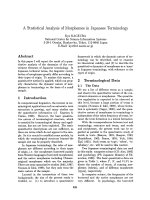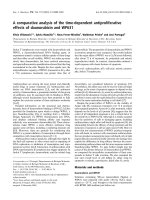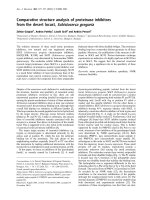Báo cáo khoa học: "Multilingual Ontological Analysis of European Directives" potx
Bạn đang xem bản rút gọn của tài liệu. Xem và tải ngay bản đầy đủ của tài liệu tại đây (90.25 KB, 4 trang )
Proceedings of the ACL 2007 Demo and Poster Sessions, pages 21–24,
Prague, June 2007.
c
2007 Association for Computational Linguistics
Multilingual Ontological Analysis of European Directives
Gianmaria Ajani
Dipartimento di Scienze Giuridiche
Universit`a di Torino - Italy
Guido Boella
Leonardo Lesmo
Alessandro Mazzei
Dipartimento di Informatica
Universit`a di Torino - Italy
[guido|lesmo|mazzei]@di.unito.it
Piercarlo Rossi
Dipartimento di Studi per l’Impresa e il Territorio
Universit`a del Piemonte Orientale - Italy
Abstract
This paper describes the main features of our
tool called “Legal Taxonomy Syllabus”. The
system is an ontology based tool designed to
annotate and recover multi-lingua legal in-
formation and build conceptual dictionaries
on European Directives.
1 Introduction
The European union each year produces a large
number of Union Directives (EUD), which are trans-
lated into each of the communitary languages. The
EUD are sets of norms that have to be implemented
by the national legislations. The problem of multi-
linguism in European legislation has recently been
addressed by using linguistic and ontological tools,
e.g. (Boer et al., 2003; Giguet and P.S., 2006; De-
spr´es and Szulman, 2006). The management of
EUD is particularly complex since the implementa-
tion of a EUD however not correspond to the straight
transposition into a national law. An EUD is subject
to further interpretation, and this process can lead to
unexpected results. Comparative Law has studied in
details the problematics concerning EUD and their
complexities. On the other hand managing with ap-
propriate tools this kind of complexity can facilitate
the comparison and harmonization of national legis-
lation (Boer et al., 2003). Based on this research, in
this paper, we describe the tool for building multilin-
gual conceptual dictionaries we developed for repre-
senting an analysing the terminology and concepts
used in EUD.
The main assumptions of our methodology, mo-
tivated by studies in comparative law (Rossi and
Vogel, 2004) and ontologies engineering (Klein,
2001), are the following ones: 1) Terms and con-
cepts must be distinguished; for this purpose, we
use lightweight ontologies, i.e. simple taxonomic
structures of primitive or composite terms together
with associated definitions. They are hardly axiom-
atized as the intended meaning of the terms used by
the community is more or less known in advance
by all members, and the ontology can be limited to
those structural relationships among terms that are
considered as relevant (Oberle, 2005)
1
. 2) We dis-
tinguish the ontology implicitly defined by EUD,
the EU level, from the various national ontologies,
the national level. Furthermore, each national leg-
islation refers to a distinct national legal ontology.
We do not assume that the transposition of an EUD
introduces automatically in a national ontology the
same concepts present at the EU level. 3) Corre-
sponding concepts at the EU level and at the national
level can be denoted by different terms in the same
national language.
In this paper, we show how the Legal Taxon-
omy Syllabus (LTS) is used to build a dictionary
of consumer law, to support the Uniform Terminol-
ogy Project
2
(Rossi and Vogel, 2004). The struc-
ture of this paper is the following one. In Section 2
we stress two main problems which comparative law
has raised concerning EUD and their transpositions.
In Section 3 we describe how the methodology of
the LTS allows to cope with these problems and fi-
nally in Section 4we give some conclusions.
1
See />2
21
2 Terminological and conceptual
misalignment
Comparative law has identified two key points in
dealing with EUD, which makes more difficult deal-
ing with the polysemy of legal terms: we call them
the terminological and conceptual misalignments.
In the case of EUD (usually adopted for harmon-
ising the laws of the Member States), the termino-
logical matter is complicated by their necessity to
be implemented by the national legislations. In or-
der to have a precise transposition in a national law,
a Directive may be subject to further interpretation.
Thus, a same legal concept can be expressed in dif-
ferent ways in a Directive and in its implementing
national law. The same legal concept in some lan-
guage can be expressed in a different way in a EUD
and in the national law implementing it. As a con-
sequence we have a terminological misalignment.
For example, the concept corresponding to the word
reasonably in English, is translated into Italian as
ragionevolmente in the EUD, and as con ordinaria
diligenza into the transposition law.
In the EUD transposition laws a further problem
arises from the different national legal doctrines.
A legal concept expressed in an EUD may not be
present in a national legal system. In this case we
can talk about a conceptual misalignment. To make
sense for the national lawyers’ expectancies, the Eu-
ropean legal terms have not only to be translated
into a sound national terminology, but they need to
be correctly detected when their meanings are to re-
fer to EU legal concepts or when their meanings are
similar to concepts which are known in the Member
states. Consequently, the transposition of European
law in the parochial legal framework of each Mem-
ber state can lead to a set of distinct national legal
doctrines, that are all different from the European
one. In case of consumer contracts (like those con-
cluded by the means of distance communication as
in Directive 97/7/EC, Art. 4.2), the notion to pro-
vide in a clear and comprehensible manner some el-
ements of the contract by the professionals to the
consumers represents a specification of the informa-
tion duties which are a pivotal principle of EU law.
Despite the pairs of translation in the language ver-
sions of EU Directives (i.e., klar und verst
¨
andlich
in German - clear and comprehensible in English -
chiaro e comprensibile in Italian), each legal term,
when transposed in the national legal orders, is in-
fluenced by the conceptual filters of the lawyers’
domestic legal thinking. So, klar und verst
¨
andlich
in the German system is considered by the German
commentators referring to three different legal con-
cepts: 1) the print or the writing of the informa-
tion must be clear and legible (gestaltung der infor-
mation), 2) the information must be intelligible by
the consumer (formulierung der information), 3) the
language of the information must be the national of
consumer (sprache der information). In Italy, the
judiciary tend to control more the formal features of
the concepts 1 and 3, and less concept 2, while in
England the main role has been played by the con-
cept 2, though considered as plain style of language
(not legal technical jargon) thanks to the historical
influences of plain English movement in that coun-
try.
Note that this kind of problems identified in com-
parative law has a direct correspondence in the on-
tology theory. In particular Klein (Klein, 2001) has
remarked that two particular forms of ontology mis-
match are terminological and conceptualization on-
tological mismatch which straightforwardly corre-
spond to our definitions of misalignments.
3 The methodology of the Legal Taxonomy
Syllabus
A standard way to properly manage large multilin-
gual lexical databases is to do a clear distinction
among terms and their interlingual acceptions (or
axies) (S´erasset, 1994; Lyding et al., 2006). In
our system to properly manage terminological and
conceptual misalignment we distinguish in the LTS
project the notion of legal term from the notion of
legal concept and we build a systematic classifica-
tion based on this distinction. The basic idea in
our system is that the conceptual backbone consists
in a taxonomy of concepts (ontology) to which the
terms can refer to express their meaning. One of
the main points to keep in mind is that we do not
assume the existence of a single taxonomy cover-
ing all languages. In fact, it has been convincingly
argued that the different national systems may orga-
nize the concepts in different ways. For instance,
the term contract corresponds to different concepts
22
EU ontology
Italian ontology
German ontology
Term-Ita-A
Term-Ger-A
EU-1
Ita-2
Ger-3
Ger-5
Ita-4
Figure 1: Relationship between ontologies and
terms. The thick arcs represent the inter-ontology
“association” link.
in common law and civil law, where it has the mean-
ing of bargain and agreement, respectively (Sacco,
1999). In most complex instances, there are no
homologous between terms-concepts such as frutto
civile (legal fruit) and income, but respectively civil
law and common law systems can achieve function-
ally same operational rules thanks to the function-
ing of the entire taxonomy of national legal concepts
(Graziadei, 2004). Consequently, the LTS includes
different ontologies, one for each involved national
language plus one for the language of EU docu-
ments. Each language-specific ontology is related
via a set of association links to the EU concepts, as
shown in Fig. 1.
Although this picture is conform to intuition, in
LTS it had to be enhanced in two directions. First,
it must be observed that the various national ontolo-
gies have a reference language. This is not the case
for the EU ontology. For instance, a given term in
English could refer either to a concept in the UK on-
tology or to a concept in the EU ontology. In the
first case, the term is used for referring to a concept
in the national UK legal system, whilst in the second
one, it is used to refer to a concept used in the Euro-
pean directives. This is one of the main advantages
of LTS. For example klar und verst
¨
andlich could re-
fer both to concept Ger-379 (a concept in the Ger-
man Ontology) and to concept EU-882 (a concept
in the European ontology). This is the LTS solution
for facing the possibility of a correspondence only
partial between the meaning of a term has in the na-
tional system and the meaning of the same term in
the translation of a EU directive. This feature en-
ables the LTS to be more precise about what “trans-
lation” means. It puts at disposal a way for asserting
that two terms are the translation of each other, but
just in case those terms have been used in the trans-
lation of an EU directive: within LTS, we can talk
about direct EU-translations of terms, but only about
indirect national-system translations of terms. The
situation enforced in LTS is depicted in Fig. 1, where
it is represented that: The Italian term Term-Ita-A
and the German term Term-Ger-A have been used as
corresponding terms in the translation of an EU di-
rective, as shown by the fact that both of them refer
to the same EU-concept EU-1. In the Italian legal
system, Term-Ita-A has the meaning Ita-2. In the
German legal system, Term-Ger-A has the meaning
Ger-3. The EU translations of the directive is cor-
rect insofar no terms exist in Italian and German that
characterize precisely the concept EU-1 in the two
languages (i.e., the “associated” concepts Ita-4
and Ger-5 have no corresponding legal terms). A
practical example of such a situation is reported in
Fig. 2, where we can see that the ontologies include
different types of arcs. Beyond the usual is-a (link-
ing a category to its supercategory), there are also
a purpose arc, which relates a concept to the legal
principle motivating it, and concerns, which refers
to a general relatedness. The dotted arcs represent
the reference from terms to concepts. Some terms
have links both to a National ontology and to the EU
Ontology (in particular, withdrawal vs. recesso and
difesa del consumatore vs. consumer protection).
The last item above is especially relevant: note
that this configuration of arcs specifies that: 1) with-
drawal and recesso have been used as equivalent
terms (concept EU-2) in some European Directives
(e.g., Directive 90/314/EEC). 2) In that context, the
term involved an act having as purpose the some
kind of protection of the consumer. 3) The terms
used for referring to the latter are consumer protec-
tion in English and difesa del consumatore in Ital-
ian. 4) In the British legal system, however, not
all withdrawals have this goal, but only a subtype
of them, to which the code refers to as cancellation
(concept Eng-3). 5) In the Italian legal system, the
term diritto di recesso is ambiguous, since it can be
used with reference either to something concerning
23
Figure 2: An example of interconnections among
terms.
the risoluzione (concept Ita-4), or to something
concerning the recesso proper (concept Ita-3).
Finally, it is possible to use the LTS to translate
terms into different national systems via the con-
cepts which they are transposition of at the European
level. For instance suppose that we want to trans-
late the legal term credito al consumo from Italian
to German. In the LTS credito al consumo is asso-
ciated to the national umeaning Ita-175. We find
that Ita-175 is the transposition of the European
umeaning EU-26 (contratto di credito). EU-26 is
associated to the German legal term Kreditvertrag
at European level. Again, we find that the national
German transposition of EU-26 corresponds to the
national umeaning Ger-32 that is associated with
the national legal term Darlehensvertrag. Then, by
using the European ontology, we can translate the
Italian legal term credito al consumo into the Ger-
man legal term Darlehensvertrag.
4 Conclusions
In this paper we discuss some features of the LTS, a
tool for building multilingual conceptual dictionar-
ies for the EU law. The tool is based on lightweight
ontologies to allow a distinction of concepts from
terms. Distinct ontologies are built at the EU level
and for each national language, to deal with poly-
semy and terminological and conceptual misalign-
ment.
Many attempts have been done to use ontology
in legal field, e.g. (Casanovas et al., 2005; De-
spr´es and Szulman, 2006) and LOIS project (that is
based on EuroWordNet project (Vossen et al., 1999),
), but to our
knowledge the LTS is the first attempt which starts
from fine grained legal expertise on the EUD do-
main.
Future work is to study how the LTS can be used
as a thesaurus for general EUD, even if the current
domain is limited to consumer law.
References
A. Boer, T.M. van Engers, and R. Winkels. 2003. Using
ontologies for comparing and harmonizing legislation.
In ICAIL, pages 60–69.
P. Casanovas, N. Casellas, C. Tempich, D. Vrandecic, and
R. Benjamins. 2005. OPJK modeling methodology.
In Proceedings of the ICAIL Workshop: LOAIT 2005.
S. Despr´es and S. Szulman. 2006. Merging of legal
micro-ontologies from european directives. Artificial
Intelligence and Law, ??:??–?? In press.
E. Giguet and P.S. 2006. Multilingual lexical database
generation from parallel texts in 20 european lan-
guages with endogenous resources. In Proceedings of
the COLING/ACL 2006 Main Conference Poster Ses-
sions, pages 271–278, July.
M. Graziadei. 2004. Tuttifrutti. In P. Birks and A. Pretto,
editors, Themes in Comparative Law, pages –. Oxford
University Press.
M. Klein. 2001. Combining and relating ontologies: an
analysis of problems and solutions. In Workshop on
Ontologies and Information Sharing, IJCAI’01, Seat-
tle, USA.
V. Lyding, Elena Chiocchetti, G. S´erasset, and F. Brunet-
Manquat. 2006. The LexALP information system:
Term bank and corpus for multilingual legal termi-
nology consolidated. In Proc. of the Wokshop on
Multilingual Language Resources and Interoperabil-
ity, ACL06, pages 25–31.
D. Oberle, editor. 2005. Semantic Management of Mid-
dleware. Springer Science+Business and Media.
P. Rossi and C. Vogel. 2004. Terms and concepts; to-
wards a syllabus for european private law. European
Review of Private Law (ERPL), 12(2):293–300.
R. Sacco. 1999. Contract. European Review of Private
Law, 2:237–240.
G. S´erasset. 1994. Interlingual lexical organization for
multilingual lexical databases in NADIA. In Proc.
COLING94, pages 278–282.
P. Vossen, W. Peters, and J. Gonzalo. 1999. Towards a
universal index of meaning. In Proc. ACL-99 Siglex
Workshop.
24









